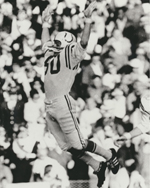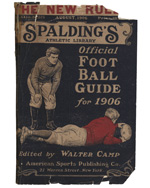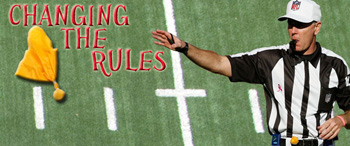Changing the Rules archived
Week 12
First down at the 55-yard line
November 27, 2011
The dimensions of a National Football League field have remained unchanged since the league's founding in 1920. The field measures 53 1/3 yards wide and 100 yards long between goal lines and also includes a pair of ten-yard deep end zones.
There has been a change, however, to the size of the field since professional football's birth in 1892. When William "Pudge" Heffelfinger was first paid $500 to play for the Allegheny Athletic Association, the length of the field was actually 110 yards long and included a 55-yard line. Also, at that time the end zones were essentially nonexistent. The goal line represented the end of the field.
It was not until 1912 that the length of the field was changed to 360 feet (120 yards), while the width remained the same (53 1/3 yards). The field was 100 yards from goal line to goal line, with ten-yard end zones, the exact same size of a football field today.

2011 NFL Rule Book Excerpt
Rule 1- The Field
Section 1 - Dimensions
PLAYING LINES
The game shall be played upon a rectangular field, 360 feet in length and 160 feet in width. The lines at each end of the field are termed End Lines.
Those on each side are termed Sidelines. Goal Lines shall be established in the field 10 yards from and parallel to each end line. The area
bounded by goal lines and sidelines is known as the Field of Play. The areas bounded by goal lines, end lines, and sidelines are known as the End
Zones.
Week 11
3rd down and five…time to punt
Nov. 20, 2011 2011 NFL Rule Book Excerpt
2011 NFL Rule Book ExcerptRule 3 - Definitions
Section 7 - Down
SERIES OF DOWNS
Article 2 A Series of Downs is the four consecutive charged scrimmage downs allotted to the offensive team during
which it must advance the ball to a yard line called the necessary line in order to retain possession.
NECESSARY LINE
The Necessary Line is always 10 yards in advance of the spot of the snap (which starts the series) except when a goal
line is less than 10 yards from this spot. In that case the necessary line is the goal line.
The number of downs and the distance to gain a first down has not always been the same. When pro football began in 1892, the offensive squad had to only gain five yards within three downs to gain a first down. In 1906 the distance then changed to 10 yards in the allotted three down allowance. Finally in 1912 a fourth down was added.
The game of professional football has changed drastically in the last 50 years. Oddly enough, the number of first downs logged by a team in each game has changed very little. Below is a ten-year sample of first down performance going back to the 1940 NFL season.
| Season | Season Average of First Downs Gained Per Team | Average Per Game |
| 1940 | 126 | 11.5 |
| 1950 | 204 | 17.0 |
| 1960 | 201 | 16.75 |
| 1970 | 221 | 15.8 |
| 1980 | 305 | 19.1 |
| 1990 | 284 | 17.8 |
| 2000 | 295 | 18.4 |
| 2010 | 303 | 18.9 |
Week 10
Scoring
Nov. 13, 2011 NFL Rule 11, Section 1, Article 2
NFL Rule 11, Section 1, Article 2Types of Scoring Plays. Points are scored as follows:
(a) Touchdown: 6 points;
(b) Field Goal: 3 points;
(c) Safety: 2 points:
(d) Successful Try after touchdown: 1 point (Field Goal or Safety) or 2 points (Touchdown)
The values of scoring have undergone several changes since the birth of professional football in 1892. So much so that if the scoring values that were in place close to 110 years ago were still the standard, it would have a dramatic effect on the outcome of many of today's games.
In fact, had an older scoring system been in place in the early '70s, the outcome of Super Bowl V would have been completely different. Baltimore Colts' first-year kicker Jim O'Brien (right) booted a 32-yard field goal in the waning seconds of that title matchup against the Dallas Cowboys. His kick broke a tie game and gave the Colts a 16-13 victory for their first Super Bowl championship. Had the scoring values from 1892 been in place, the Colts would have needed to score a touchdown and convert their extra point just to tie the game.
| Super Bowl V Score | TDs | 1892 Value | PATs | 1892 Value | FGs | 1892 Value | Safety | 1892 Value | 1892 Total |
| Baltimore Colts - 16 | 2 | 8 | 1 | 2 | 1 | 5 | 0 | 0 | 15 |
| Dallas Cowboys - 13 | 1 | 4 | 1 | 2 | 2 | 10 | 0 | 0 | 16 |
| Pro football scoring values in 1892: TD = 4 pts; PAT = 2 pts; Field Goal = 5 pts; Safety = 2 pts. | |||||||||
Here are some of the changes to the game's rule book as it pertains to scoring.
1897 – Touchdown increased to 5 points; Point After Try reduced to 1 point
1904 – Field Goal reduced to 4 points
1909 – Field Goal reduced to 3 points
1912 – Touchdown increased to 6 points
1994 – Two-point conversion adopted by the NFL as option following a touchdown
Each Sunday during the NFL season we examine one of the league rules that shape the game as we know it.
Week 9
The Forward Pass
Nov. 6, 2011 The forward pass has been a legal practice in the game of professional football since 1906. George “Peggy” Parratt of the Massillon (Ohio) Tigers holds the distinction as being the first man in pro football history to successfully complete a pass. Parratt hooked up with end Dan “Bullet” Riley against the combined Benwood-Moundsville, W. Va. team on Oct. 25 that year.
The forward pass has been a legal practice in the game of professional football since 1906. George “Peggy” Parratt of the Massillon (Ohio) Tigers holds the distinction as being the first man in pro football history to successfully complete a pass. Parratt hooked up with end Dan “Bullet” Riley against the combined Benwood-Moundsville, W. Va. team on Oct. 25 that year.The rule change to allow passing was actually predicated by the college rule book. Professional football at the time, mostly because there was no organized league, strictly adhered to the college rules of the day.
At that time, however, the passing game did not resemble the air-it-out type of attack that teams operate today. In fact, the rules in place didn’t really encourage the pass at all. To legally pass the ball, the thrower had to be at least five yards behind the line of scrimmage. The penalty if this rule was not adhered to: a turnover to the defense. The rules even stipulated that if a pass was incomplete and untouched by either team the ball would also turn over to the defense.
1906 Spalding’s Official Foot Ball Guide excerpt
Rule 14
(a) A player may throw, pass, or bat the ball in any direction except toward his opponents’ goal.
Loss of 5 yards.
(1) One forward pass shall be allowed to each scrimmage, provided such pass be made by a player who was behind the line of scrimmage when the
ball was put in play, and provided the ball, after being passed forward, does not touch the ground before being touched by a player of either side.
(1) If a forward pass be made by a player who was not behind the line of scrimmage when the ball was put in play, the ball shall go to the opponents
on the spot where the pass was made.
where the pass was made.
This change grew out of a controversial touchdown pass thrown by Chicago Bears fullback Bronko Nagurski in the 1932 indoor playoff game that decided the ’32 league title. In that game against the Portsmouth Spartans, Nagurski faked a run towards the line and then quickly threw a TD pass to Red Grange. The Spartans contested that Nagurski was not five yards behind the line when he fired the pass. The play stood and the Bears later added a safety to put the final touches on their 9-0 victory.
At the league meetings the next off season, Spartans coach George “Potsy” Clark lobbied for a change in the rules to allow passes anywhere behind the line of scrimmage as he argued “because Nagurski will do it anyway!”
1933 NFL Rule Book Excerpt
Forward Pass
The passer may pass the ball from any point behind the line of scrimmage.
Archived "Changing the Rules"
Weeks 1-4
Weeks 5-8
Remember When…Week 13 edition
Patrick Peterson’s rookie season is reminiscent of a year recorded in the 1950s by a future Hall of Famer.


